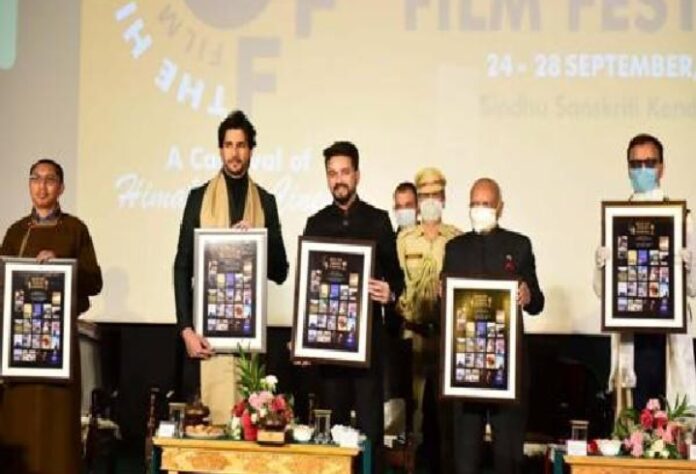Union Minister for Information and Broadcasting Anurag Thakur on Friday while inaugurating the star-studded five-day First Himalayan Film Festival in Leh said that Jammu and Kashmir and Ladakh will soon be connected with the film training institute.The five-day film festival is a part of the celebrations of Azadi Ka Amrit Mahotsav commemorating 75 years of India’s Independence. Keeping in view the Prime Minister’s call for ‘Jan Bhagidhari’, the film festival will have active participation from the local filmmakers and will showcase talent across 12 Himalayan states and Union Territories.The Minister said, “The current Narendra Modi Government will give a new identity to the hill States and the Minister and Ministry of Information and Broadcasting will work relentlessly towards that goal.”The Minister added, “The Himalayan states have a diverse culture and have a lot to showcase. The youth of these States need opportunities to display their talent. Cinemas provide a platform to bring all cultural diversities together. The world of cinema provides a prominent platform for the culture of the country.”Speaking about the valour of the people of Ladakh, the Minister said, “The people of the region stand shoulder to shoulder with our brave soldiers in the protection of our borders. Movies like Shershaah remind many generations of the valour of our soldiers who fought bravely in the wars. Such movies are a great contribution that will inspire generations to come.”Anurag Thakur speaking on the rising charm of OTT platforms said, “India is a country where the popularity of OTT platforms is increasing. This presents an opportunity, not just for the big states but even the smaller States of the country and soon Ladakh is going to find recognition even in international film festivals in the future.”Highlighting the popularity of good content on OTT platforms, the Minister said that India is the fastest-growing OTT market and it is the content that is drawing people to the OTT platforms.”The power lies in content and India can become the subcontinent of content creation of the world. But we need to groom our people to produce that quality content. Post-production work for many international blockbusters was done in India and the sector along with the gaming and visual graphics sector provide an immense space for growth,” he added.Thakur said that there has been a persistent demand that Jammu and Kashmir and Ladakh be connected with a film training institute. He subsequently announced that this idea will be implemented soon.’Shershaah’, the biographical war movie based on Param Vir Chakra awardee Captain Vikram Batra was also screened during the opening ceremony in presence of its director, Vishnuvardhan and the lead actor Sidharth Malhotra.A food festival showcasing the unique cuisines of the Ladakh region, a cultural show showcasing the rich cultural varsity of Ladakh and a music fest will be also be held during the ongoing film festival.The five days film festival kick-started on Friday up to September 28 and is organised by the Administration of Union Territory of Ladakh in collaboration with the Directorate of Film Festivals, Ministry of Information and Broadcasting, Government of India.Prior to mention, the Himalayan Region of India attracts filmmakers from all around the globe due to its unique scenic endowment. The unique geography of the region is widely documented along with its indigenous people, traditional skills, and occupations. Film festival in this context presents an opportunity for the local filmmakers to narrate their stories to a wider audience.In the last two decades, the Independent film industry in the region has taken shape with filmmakers producing local-language films. The same period has also seen rapid electrification in the region which is the prerequisite for the development of the audio-visual sector.The ‘Himalayan Film Festival’ also envisions institutionalizing a Himalayan Film Fraternity which will have productive repercussions for filmmaking in the Himalayan parts of India.
ABOUT US
Sach News® - raising the voice of people of Jammu Kashmir since 1940. We are Publishing House of Daily Sach (Urdu Daily). Sach News, is one of the Oldest News Group of India having its office in Jammu Kashmir, Delhi. Reach us for Latest news on politics, sports, crime, education, real estate, business entertainment and much more. We provide you with the latest breaking news and videos straight from the ground zero.
Contact us: [email protected]
© Sach News Network 2011-2024 | Maintained by Sach Info Tech


